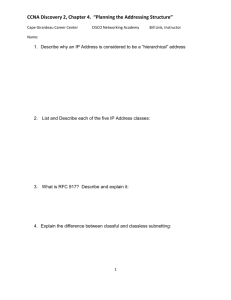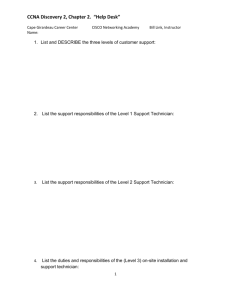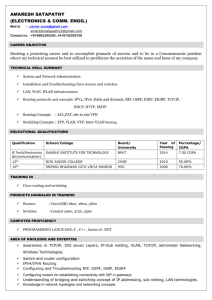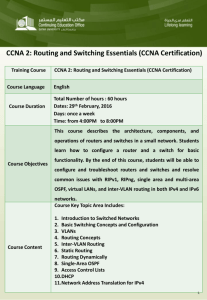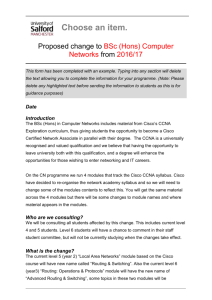CCNA Discovery 2, Chapter 6. “Routing” Worksheet Cape Girardeau
advertisement
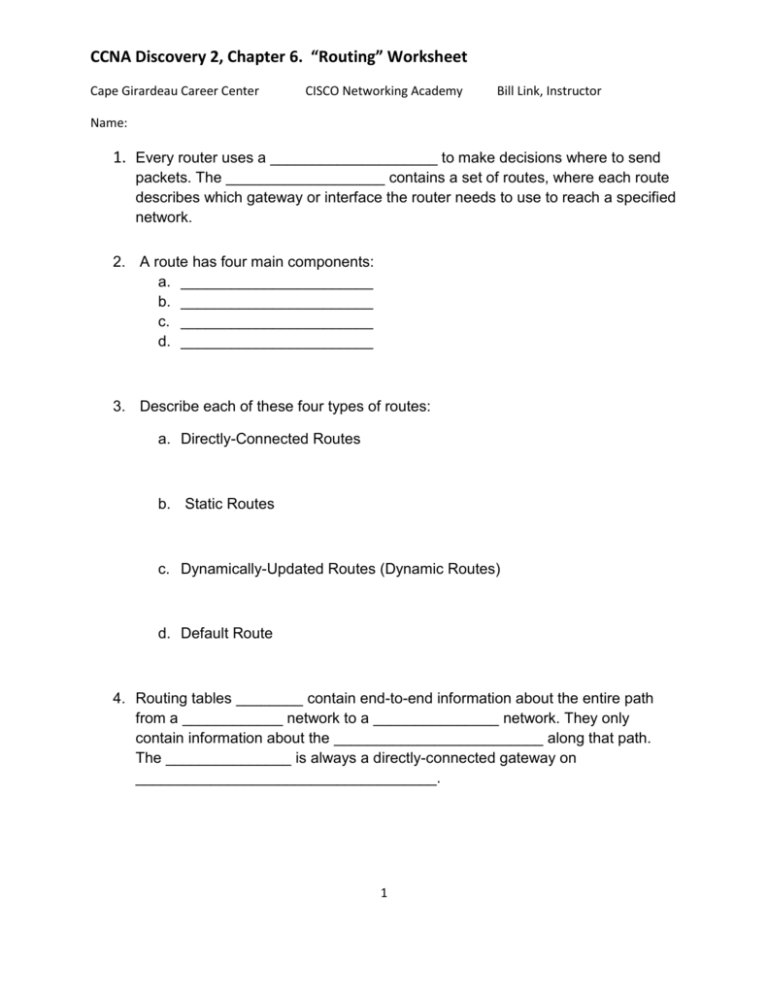
CCNA Discovery 2, Chapter 6. “Routing” Worksheet Cape Girardeau Career Center CISCO Networking Academy Bill Link, Instructor Name: 1. Every router uses a ____________________ to make decisions where to send packets. The ___________________ contains a set of routes, where each route describes which gateway or interface the router needs to use to reach a specified network. 2. A route has four main components: a. _______________________ b. _______________________ c. _______________________ d. _______________________ 3. Describe each of these four types of routes: a. Directly-Connected Routes b. Static Routes c. Dynamically-Updated Routes (Dynamic Routes) d. Default Route 4. Routing tables ________ contain end-to-end information about the entire path from a ____________ network to a _______________ network. They only contain information about the _________________________ along that path. The _______________ is always a directly-connected gateway on ____________________________________. 1 CCNA Discovery 2, Chapter 6. “Routing” Worksheet Cape Girardeau Career Center CISCO Networking Academy Bill Link, Instructor 5. Explain why larger networks generally use dynamic routing rather than static routes: 6. Do Packet Tracer activity 6.1.1 “Configuring Static Routes” 7. What do routers use routing protocols to accomplish? 8. The method that a routing protocol uses to determine the best route to a destination network is called a _________________________________. 9. What are the two main classes of routing algorithms? 10. Whenever the topology of a network changes because of reconfiguration or failure, the __________________________ in all the routers must also change to reflect an accurate view of the new topology. When all the routers in a network have updated their _____________ to reflect the new route, the routers are said to have ___________________________. 11. In order for two routers to exchange routes, they must be using __________________ and therefore ______________________________. 2 CCNA Discovery 2, Chapter 6. “Routing” Worksheet Cape Girardeau Career Center CISCO Networking Academy Bill Link, Instructor 12. The distance vector algorithm evaluates the route information it receives from other routers in terms of two basic criteria. List and describe them: 13. The distance component of a route is expressed in terms of a route cost, or metric. List the variables that can represent a routing metric: 14. Print, complete and submit Lab 6.1.2 “Creating a Network Diagram from Routing Tables” 15. Routing Information Protocol (RIP) is a ____________________routing protocol that is used in thousands of networks throughout the world. 16. List the key characteristics of RIP: 3 CCNA Discovery 2, Chapter 6. “Routing” Worksheet Cape Girardeau Career Center CISCO Networking Academy Bill Link, Instructor 17. Why is RIP a widely used and popular routing protocol? 18. List the disadvantages of RIP: 19. Explain the most significant difference between RIP version 1 and 2: 20. Explain the limitations of other distance vector routing protocols such as RIP which prompted the development of EIGRP: 4 CCNA Discovery 2, Chapter 6. “Routing” Worksheet Cape Girardeau Career Center CISCO Networking Academy Bill Link, Instructor 21. The key characteristics of EIGRP are: 22. What two additional database tables does EIGRP create? Explain each: 23. Unlike RIP, which is limited to small simple networks of less than 15 hops, EIGRP is ideal for ____________________________ networks up to _____hops in size that require ____________________________. 24. In what significant way does the Link-State routing algorithm differ from the distance vector routing algorithm? 25. List the features of Link-State routing: 5 CCNA Discovery 2, Chapter 6. “Routing” Worksheet Cape Girardeau Career Center CISCO Networking Academy Bill Link, Instructor 26. What is OSPF? 27. List the key characteristics of OSPF: 28. In OSPF enabled networks, when do routers send link state advertisements to each other? 29. Small networks with only one gateway to the Internet can probably use ______________________. 30. As an organization grows and adds routers to its network topology, _______________ can be used. It is easy to configure and in small networks can work well. When a network begins to exceed 15 routers, ________ is no longer a good choice. 6 CCNA Discovery 2, Chapter 6. “Routing” Worksheet Cape Girardeau Career Center CISCO Networking Academy Bill Link, Instructor 31. For larger networks, what are the main criteria in helping settle on a routing protocol? 32. For the most basic RIP configuration, list the three modes and commands to remember: 33. List and explain each of the following ways to verify that RIP is functioning properly in the network: a. Ping b. The show ip protocols command c. The show ip route command d. The debug ip rip command 7 CCNA Discovery 2, Chapter 6. “Routing” Worksheet Cape Girardeau Career Center CISCO Networking Academy Bill Link, Instructor 34. Do the Packet Tracer activity 6.1.5 “Configure and Verify RIP” 35. Print, complete, and submit Lab 6.1.5 “Configure and Verify RIP” 36.Explain what an Autonomous System (AS) is and give an example: 37. Define what an ASN is: 38. Describe what an IGP is and give three examples: 39. Describe what an EGP is and where it would be used: 40. The most common exterior routing protocol on the Internet today is ____________________________. It is estimated that ____% of Autonomous Systems use _________. The most current version of ________ is version______ (______________) for which the latest description is provided in RFC 4271. 8 CCNA Discovery 2, Chapter 6. “Routing” Worksheet Cape Girardeau Career Center CISCO Networking Academy Bill Link, Instructor 41. Describe what a border gateway is: 42. Describe how Exterior gateway protocols provide many useful features for ISPs: 43. Internet traffic can be categorized in one of two ways. Describe each: a. Local traffic b. Transit traffic 44. Why are many Autonomous Systems not willing to carry transit traffic? 45. What is the first step in enabling BGP on a router and what is the command used to accomplish this? 9 CCNA Discovery 2, Chapter 6. “Routing” Worksheet Cape Girardeau Career Center CISCO Networking Academy Bill Link, Instructor 46. What is the next step in enabling BGP and what command is used? 47. How do you configure a router to use BGP to advertise an internal route? 48. On the Internet, BGP should ___________________________ to advertise a private network address. 49. Print, complete, and submit Lab 6.2.5 “Configuring a Router to Use BGP” 10
